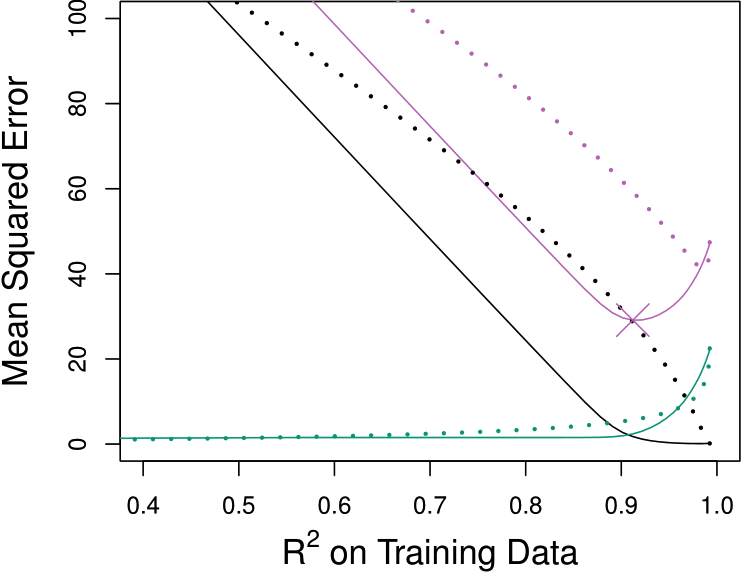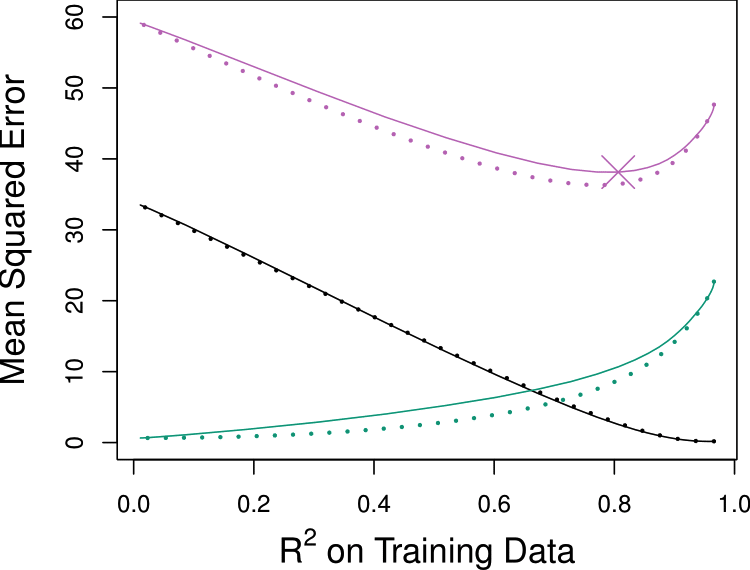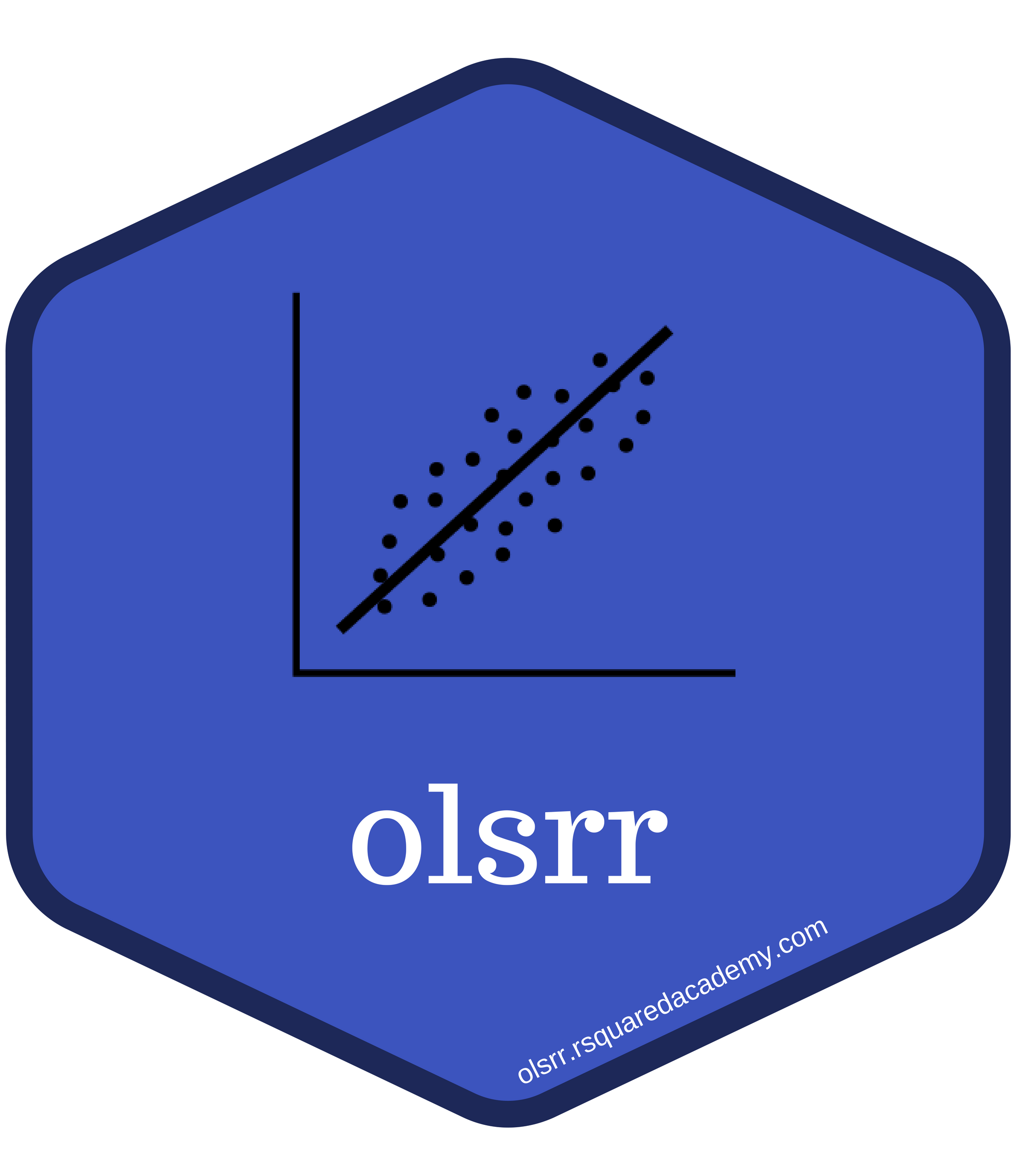| lcavol | lweight | age | lbph | svi | lcp | gleason | pgg45 | lpsa | train |
|---|---|---|---|---|---|---|---|---|---|
| -0.580 | 2.77 | 50 | -1.386 | 0 | -1.39 | 6 | 0 | -0.431 | TRUE |
| -0.994 | 3.32 | 58 | -1.386 | 0 | -1.39 | 6 | 0 | -0.163 | TRUE |
| -0.511 | 2.69 | 74 | -1.386 | 0 | -1.39 | 7 | 20 | -0.163 | TRUE |
| -1.204 | 3.28 | 58 | -1.386 | 0 | -1.39 | 6 | 0 | -0.163 | TRUE |
| 0.751 | 3.43 | 62 | -1.386 | 0 | -1.39 | 6 | 0 | 0.372 | TRUE |
| -1.050 | 3.23 | 50 | -1.386 | 0 | -1.39 | 6 | 0 | 0.765 | TRUE |
| 0.737 | 3.47 | 64 | 0.615 | 0 | -1.39 | 6 | 0 | 0.765 | FALSE |
| 0.693 | 3.54 | 58 | 1.537 | 0 | -1.39 | 6 | 0 | 0.854 | TRUE |
Feature Selection and LASSO ![]()
MSSC 6250 Statistical Machine Learning
Department of Mathematical and Statistical Sciences
Marquette University
Feature/Variable Selection
When OLS Doesn’t Work Well
When \(p \gg n\), it is often that many of the features in the model are not associated with the response.
Model Interpretability: By removing irrelevant features \(X_j\)s, i.e., setting the corresponding \(\beta_j\)s to zero, we can obtain a model that is more easily interpreted. (Feature/Variable selection)
Least squares is unlikely to yield any coefficient estimates that are exactly zero.
Variable Selection
- We have a large pool of candidate regressors, of which only a few are likely to be important.
Two “conflicting” goals in model building:
as many features as possible for better predictive performance on new data (smaller bias).
-
as few regressors as possible because as the number of regressors increases,
- \(\mathrm{Var}(\hat{y})\) will increase (larger variance)
- cost more in data collecting and maintaining
- more model complexity
A compromise between the two hopefully leads to the “best” regression equation.
What does best mean?
There is no unique definition of “best”, and different methods specify different subsets of the candidate regressors as best.
Three Classes of Methods
-
Subset Selection (ISL Sec. 6.1) Identify a subset of the \(p\) predictors that we believe to be related to the response.
- Need a selection method and a selection criterion.
-
Shrinkage (ISL Sec. 6.2) Fit a model that forces some coefficients to be shrunk to zero.
-
Lasso
glmnet::glmnet()
-
Lasso
-
Dimension Reduction (ISL Sec. 6.3) Find \(m\) representative features that are linear combinations of the \(p\) original predictors (\(m \ll p\)), then fit least squares.
- Principal component regression (Unsupervised)
pls::pcr() - Partial least squares (Supervised)
pls::plsr()
- Principal component regression (Unsupervised)
Subset Selection
- MSSC 5780 slides and ISL Sec. 6.1
Selection Criteria
- An evaluation metric should consider Goodness of Fit and Model Complexity:
Goodness of Fit: The more regressors, the better
Complexity Penalty: The less regressors, the better
- Evaluate subset models:
- \(R_{adj}^2\) \(\uparrow\)
- Mallow’s \(C_p\) \(\downarrow\)
- Information Criterion (AIC, BIC) \(\downarrow\)
- PREdiction Sum of Squares (PRESS) \(\downarrow\) (Allen, D.M. (1974))
Lasso (Least Absolute Shrinkage and Selection Operator) ![]()
Why Lasso?
-
Subset selection methods
- may be computationally infeasible (fit OLS over millions of times)
- do not explore all possible subset models (no global solution)
Ridge regression does shrink coefficients, but still include all predictors.
Lasso regularizes coefficients so that some coefficients are shrunk to zero, doing feature selection.
Like ridge regression, for a given \(\lambda\), Lasso only fits a single model.
What is Lasso?
Different from the Ridge regression that adds \(\ell_2\) norm, Lasso adds \(\ell_1\) penalty on the parameters:
\[\begin{align} \widehat{\boldsymbol \beta}^\text{l} =& \, \, \mathop{\mathrm{arg\,min}}_{\boldsymbol \beta} \lVert \mathbf{y}- \mathbf{X}\boldsymbol \beta\rVert_2^2 + n \lambda \lVert\boldsymbol \beta\rVert_1\\ =& \, \, \mathop{\mathrm{arg\,min}}_{\boldsymbol \beta} \frac{1}{n} \sum_{i=1}^n (y_i - x_i' \boldsymbol \beta)^2 + \lambda \sum_{j=1}^p |\beta_j|, \end{align}\]
- The \(\ell_1\) penalty forces some of the coefficient estimates to be exactly equal to zero when \(\lambda\) is sufficiently large, yielding sparse models.
\(\ell_2\) vs. \(\ell_1\)
- Ridge shrinks big coefficients much more than lasso.
- Lasso has larger penalty on small coefficients.

ElemStatLearn::prostate Data
cv.glmnet(alpha = 1)

Lasso Coefficients
lambda.mincontains more nonzero coefficients.Larger penalty \(\lambda\) forces more coefficients to be zero, and the model is more “sparse”.
One-Variable Lasso and Shrinkage: Concept
Lasso solution does not have an analytic or closed form in general.
Consider the univariate regression model
\[\underset{\beta}{\mathop{\mathrm{arg\,min}}} \quad \frac{1}{n} \sum_{i=1}^n (y_i - x_i \beta)^2 + \lambda |\beta|\]
With some derivation, and also utilize the OLS solution of the loss function, we have
\[\begin{align} &\frac{1}{n} \sum_{i=1}^n (y_i - x_i \beta)^2 \\ =& \frac{1}{n} \sum_{i=1}^n (y_i - x_i b + x_i b - x_i \beta)^2 \\ =& \frac{1}{n} \sum_{i=1}^n \Big[ \underbrace{(y_i - x_i b)^2}_{\text{I}} + \underbrace{2(y_i - x_i b)(x_i b - x_i \beta)}_{\text{II}} + \underbrace{(x_i b - x_i \beta)^2}_{\text{III}} \Big] \end{align}\]
One-Variable Lasso and Shrinkage: Concept
\[\begin{align} & \sum_{i=1}^n 2(y_i - x_i b)(x_i b - x_i \beta) = (b - \beta) {\color{OrangeRed}{\sum_{i=1}^n 2(y_i - x_i b)x_i}} = (b - \beta) {\color{OrangeRed}{0}} = 0 \end{align}\]
Our original problem reduces to just the third term and the penalty
\[\begin{align} &\underset{\beta}{\mathop{\mathrm{arg\,min}}} \quad \frac{1}{n} \sum_{i=1}^n (x_ib - x_i \beta)^2 + \lambda |\beta| \\ =&\underset{\beta}{\mathop{\mathrm{arg\,min}}} \quad \frac{1}{n} \left[ \sum_{i=1}^n x_i^2 \right] (b - \beta)^2 + \lambda |\beta| \end{align} \] Without loss of generality, assume that \(x\) is standardized with mean 0 and variance \(\frac{1}{n}\sum_{i=1}^n x_i^2 = 1\).
One-Variable Lasso and Shrinkage: Concept
This leads to a general problem of
\[\underset{\beta}{\mathop{\mathrm{arg\,min}}} \quad (\beta - b)^2 + \lambda |\beta|,\] For \(\beta > 0\),
\[\begin{align} 0 =& \frac{\partial}{\partial \beta} \,\, \left[(\beta - b)^2 + \lambda |\beta| \right] = 2 (\beta - b) + \lambda \\ \Longrightarrow \quad \beta =&\, b - \lambda/2 \end{align}\]
\[\begin{align} \widehat{\beta}^\text{l} &= \begin{cases} b - \lambda/2 & \text{if} \quad b > \lambda/2 \\ 0 & \text{if} \quad |b| \le \lambda/2 \\ b + \lambda/2 & \text{if} \quad b < -\lambda/2 \\ \end{cases} \end{align}\]
Lasso provides a soft-thresholding solution.
When \(\lambda\) is large enough, \(\widehat{\beta}^\text{l}\) will be shrunk to zero.
Objective function
The objective function is \((\beta - 1)^2\). Once the penalty is larger than 2, the optimizer would stay at 0.
Variable Selection Property and Shrinkage
The proportion of times a variable has a non-zero parameter estimation.
\(\mathbf{y}= \mathbf{X}\boldsymbol \beta + \epsilon = \sum_{j = 1}^p X_j \times 0.4^{\sqrt{j}} + \epsilon\)
\(p = 20\), \(\epsilon \sim N(0, 1)\) and replicate 100 times.

Bias-Variance Trade-off

Comparing Lasso and Ridge
Constrained Optimization
For every value of \(\lambda\), there is some \(s\) such that the two optimization problems are equivalent, giving the same coefficient estimates.
The \(\ell_1\) and \(\ell_2\) penalties form a constraint region that \(\beta_j\) can move around or budget for how large \(\beta_j\) can be.
Larger \(s\) (smaller \(\lambda\)) means a larger region \(\beta_j\) can freely move.
Lasso \[\begin{align} \min_{\boldsymbol \beta} \,\,& \lVert \mathbf{y}- \mathbf{X}\boldsymbol \beta\rVert_2^2 + n\lambda\lVert\boldsymbol \beta\rVert_1 \end{align}\]
\[\begin{align} \min_{\boldsymbol \beta} \,\,& \lVert \mathbf{y}- \mathbf{X}\boldsymbol \beta\rVert_2^2\\ \text{s.t.} \,\, & \sum_{j=1}^p|\beta_j| \leq s \end{align}\]
Ridge \[\begin{align} \min_{\boldsymbol \beta} \,\,& \lVert \mathbf{y}- \mathbf{X}\boldsymbol \beta\rVert_2^2 + n\lambda\lVert\boldsymbol \beta\rVert_2^2 \end{align}\]
\[\begin{align} \min_{\boldsymbol \beta} \,\,& \lVert \mathbf{y}- \mathbf{X}\boldsymbol \beta\rVert_2^2\\ \text{s.t.} \,\, & \sum_{j=1}^p \beta_j^2 \leq s \end{align}\]
Geometric Representation of Optimization
What do the constraints look like geometrically?
When \(p = 2\),
- the \(\ell_1\) constraint is \(|\beta_1| + |\beta_2| \leq s\) (diamond)
- the \(\ell_2\) constraint is \(\beta_1^2 + \beta_2^2 \leq s\) (circle)

Way of Shrinking (\(p = 1\) and standardized \(x\))
Lasso Soft-thresholding
\[\begin{align} \widehat{\beta}^\text{l} &= \begin{cases} b - \lambda/2 & \text{if} \quad b > \lambda/2 \\ 0 & \text{if} \quad |b| < \lambda/2 \\ b + \lambda/2 & \text{if} \quad b < -\lambda/2 \\ \end{cases} \end{align}\]

Ridge Proportional shrinkage
\[\begin{align} \widehat{\beta}^\text{r} = \dfrac{b}{1+\lambda}\end{align}\]

Predictive Performance
Perform well (lower test MSE) when
Lasso (—)
A relatively small number of \(\beta_j\)s are substantially large, and the remaining \(\beta_k\)s are small or equal to zero.
Reduce more bias

Ridge (\(\cdots\cdots\))
The response is a function of many predictors, all with coefficients of roughly equal size.
Reduce more variance

Notes of Lasso
Warning
Even Lasso does feature selection, do not add predictors that are known to be not associated with the response in any way.
Curse of dimensionality. The test MSE tends to increase as the dimensionality \(p\) increases, unless the additional features are truly associated with the response.
Do not conclude that the predictors with non-zero coefficients selected by Lasso and other selection methods predict the response more effectively than other predictors not included in the model.
Other Topics
- Combination \(\ell_1\) and \(\ell_2\): Elastic net penalty (Zou and Hastie, 2005)
\[\lambda \left[ (1 - \alpha) \lVert \boldsymbol \beta\rVert_2^2 + \alpha \lVert\boldsymbol \beta\lVert_1 \right]\]
- General \(\ell_q\) penalty: \(\lambda \sum_{j=1}^p |\beta_j|^q\)

Other Topics
-
Algorithms
- Shooting algorithm (Fu 1998)
- Least angle regression (LAR) (Efron et al. 2004)
- Coordinate descent (Friedman et al 2010) (used in
glmnet)
-
Variants
- Adaptive Lasso
- Group Lasso
- Bayesian Lasso, etc.

